DWC (Need a little help)
1. Can I use the compressed moss pellets (the jiffy pellets you can get anywhere) inside of the basket filled with clay balls?
2. I am using 3 air stones in a 10 gallon container...any benefits to having 3?
3. Should I have the nutrients circulating...I mean is there any benefit to a circulation pump inside the container?
4. How many lights...or how much light...do I need on average for seedlings? I have one 18" florescent at the moment. Is that enough? Should I add any incandescent lights to help out?
Comments (27)
cole_robbie
11 years agolast modified: 9 years ago1. Can I use the compressed moss pellets (the jiffy pellets you can get anywhere) inside of the basket filled with clay balls?
I think that should be ok to start seeds.
2. I am using 3 air stones in a 10 gallon container...any benefits to having 3?
Air pumps aerate from surface agitation. The more, the better.
3. Should I have the nutrients circulating...I mean is there any benefit to a circulation pump inside the container?
Are the roots hanging into the container? If it is where the roots are, then you want circulation. If you are talking about a remote reservoir, it cannot hurt, but it will not help as much as circulation around the roots.
4. How many lights...or how much light...do I need on average for seedlings? I have one 18" florescent at the moment. Is that enough? Should I add any incandescent lights to help out?
That is not much light at all. Do not bother with incandescents. I suggest the spiral flourescent lights. If you just buy the fixture and wire it yourself, which is very easy, you can get a lot of lumens for not very much money. The bulb is $5 US and the socket is $2. Stick $2 of sheet metal behind the bulb as a reflector, and you just made a $150 grow light.
ethnobotany
11 years agolast modified: 9 years ago"2. I am using 3 air stones in a 10 gallon container...any benefits to having 3?
Air pumps aerate from surface agitation. The more, the better. "
Reply:
From surface agitation? That's a little true, but air pumps mostly aerate by bringing fresh air from outside the tank and then blowing it directly in the water.You don't need a water pump in a DWC. The air pumps will agitate the water.
"4. How many lights...or how much light...do I need on average for seedlings? I have one 18" florescent at the moment. Is that enough? Should I add any incandescent lights to help out?
That is not much light at all. Do not bother with incandescents. I suggest the spiral flourescent lights. If you just buy the fixture and wire it yourself, which is very easy, you can get a lot of lumens for not very much money. The bulb is $5 US and the socket is $2. Stick $2 of sheet metal behind the bulb as a reflector, and you just made a $150 grow light. "
Reply:
This couldn't be farther from the truth. For the most part, when you spend $150 on a light setup you get what you pay for. A "spiral" bulb is called a Compact Fluorescent (CFL) and can produce lots of light, but you need a large one to get enough light to grow a plant well, especially plants that fruit. Its a matter of lumens, really. With a regular $2 CFL bulb you will not get anywhere near the lumens that a $30-40 MH or HPS bulb will put out.Outside is the best way to go if you want cheap.
Related Professionals
Londonderry Landscape Architects & Landscape Designers · Southfield Landscape Architects & Landscape Designers · Edmond Landscape Contractors · Goodyear Landscape Contractors · Arlington Landscape Contractors · Alamo Landscape Contractors · Hawaii Landscape Contractors · Hicksville Landscape Contractors · Indio Landscape Contractors · Milford Mill Landscape Contractors · Mission Bend Landscape Contractors · Oklahoma City Landscape Contractors · West Palm Beach Landscape Contractors · Wilton Landscape Contractors · Casselberry Landscape Contractorscole_robbie
11 years agolast modified: 9 years agoYou don't need a water pump in a DWC. The air pumps will agitate the water.
Air pumps do a very poor job compared to water pumps. You can blow all the air in that you want, but it does not affect the oxygen content of the water until the bubble moves the surface and pops.
For the most part, when you spend $150 on a light setup you get what you pay for.
I think anything labeled "hydroponics" is overpriced.
Regarding building a cfl, here is a sample bulb:
http://www.amazon.com/47452-equivalent-Energy-Smart-Spiral/dp/B000S5OK12I can't find one cheaper online, but they are $9 at menards.
Here is the socket:
http://www.amazon.com/Leviton-8829-CW1-One-Piece-Incandescent-Lampholder/dp/B000HJ97AS/ref=sr_1_3?s=hi&ie=UTF8&qid=1342670228&sr=1-3&keywords=lampholderI think they are $2.99 at menards.
Here is a 125 watt cfl fixture for $80:
http://www.wormsway.com/detail.aspx?sku=SCFF190It is a smaller light, but I still thought the price would be higher. You need a bit of plywood to mount the socket to and a piece of scrap metal for the reflector, as well as a scrap of wiring to wire it, but those things are all easy. If you were building several at once, the price difference in building your own would add up quickly.
My advice is to never buy anything labeled "hydroponics" if you can help it at all. It seems like that one word doubles the price of anything. And yes, obviously if you are trying to fruit anything, hid is far superior. But still, buy a security light, or buy the fixture and bulb and wire it yourself.
If the OP has the money and wants to splurge, he should get a digital 400-600 watt mh or hps, depending upon what he wants to grow. A 600 is a lot of light and heat in a space that small, but with enough airflow I think it could be done.
grizzman
11 years agolast modified: 9 years agoGrowNewb
for seedlings, one 18" flourescent isn't enough, but two or three should be fine. you just have to keep them right on top of the plants
If your final plants are going to be much taller than 6" or so, you need to find another light source to get adequate light penetration.
If I were going to grow inside, I would invest in a digital 400W MH. That's the best bang for your buck. But I am rational and have an abundance of sun so I let nature do that part.ethnobotany
11 years agolast modified: 9 years ago"Air pumps do a very poor job compared to water pumps. You can blow all the air in that you want, but it does not affect the oxygen content of the water until the bubble moves the surface and pops. "
Before I commence, it is probably best that you understand I am about to graduate with a BS in Cell and Molecular Biology, and have taken 2 years of chemistry courses. I mention this not to gloat, but so that you understand I am well equipped with education in the department of atoms and molecules interacting.
I think you are either over or under thinking this concept. What you say is true about waterfalls where the water falling and bubbling creates air pockets which aerates the water.
With a bubbler, however, you are doing something totally different. The air is being brought in by a pump and as the air bubbles move through the water, O2 is absorbed.
OP, you shouldn't have too much trouble with a DWC, they are in my opinion one of the easiest setups for hydroponics.
cole_robbie
11 years agolast modified: 9 years agoCongratulations on your college accomplishments. I have an advanced degree myself. It's not in science, but I have been building hydro systems since about the time you were in middle school :)
as the air bubbles move through the water, O2 is absorbed.
Nope. Sorry, but you're wrong. Technically, there is an iota of truth to what you're saying, which is the confusing part, but it is only true to a very tiny extent. Air pumps work from surface agitation, not the magic bubble theory. Ask the fish people; they will tell you that air pumps are a joke compared to moving water if you are trying to aerate.
ethnobotany
11 years agolast modified: 9 years ago"Air pumps work from surface agitation, not the magic bubble theory. Ask the fish people; they will tell you that air pumps are a joke compared to moving water if you are trying to aerate."
Did I ever tell you that water pumps are inferior to air pumps? No. Did I ever say that air pumps are replacements for water pumps? No.
What I said was that air pumps aerate the water. I also noted that upward agitation of the air bubbles at the air/water interface isn't how the water gets aerated with air pumps. Key word is air pumps. I never said that this was true with water pumps.
Apparently you cannot get with the times. You need to understand - air pumps aerate the water through dissolving O2 as it rises through the tub of water.
With your rationale, it seems that it would be best to place the air bubbler at the top of the water so that it may splatter like a motorboat at the air/water interface for "maximum aeration."
cole_robbie
11 years agolast modified: 9 years agoActually, yes, you are correct about that last part. That is the only worthwhile use of air pumps. 90% of your dissolved oxygen is in the top one inch of water. Anything you can do to get splatter off that surface and up into the air will send highly oxygenated and tiny bits of water up into the air. For low-budget aeroponics, that is ten times better that squirting water up into the air with a mag-drive pump. The problem is that a $6 air pump can only power a very small area with this method. You need a bigger air pump, which cost more, and then you might as well be buying a water pump.
Look up the machine that General Hydroponics has been selling for a long time called the "aeroflow." One of the reasons that machine is so successful is that despite being referred to as an NFT system, the design also incorporates benefits from recirculating DWC as well as surface splatter of that highly oxygenated surface water. They don't bother with an air stone, though, because it is a waste of time.
air pumps aerate the water through dissolving O2 as it rises through the tub of water.
The confusing part is that you are about 1% right. What you are saying does happen. It's just that it happens so little, that it might as well not. Technically, each bubble's surface area would count as an increase in surface area while they were underwater. But the amount is very small and inconsequential.
Look at nature. Lakes and ponds get aerated when the wind blows over them and creates surface agitation. That's the key to aeration, and that's why blowing bubbles does work to some extent.
ethnobotany
11 years agolast modified: 9 years agoAlright old man without a science degree, we will just have to agree to disagree.
"Fine bubble aeration is an efficient way to transfer oxygen to a pond. A compressor on shore pumps air through a hose, which is connected to an underwater aeration unit. Attached to the unit are a number of diffusers. These diffusers come in the shape of discs, plates, tubes or hoses constructed from glass-bonded silica, porous ceramic plastic, or perforated membranes made from EPDM (ethylene propylene diene Monomer) rubber.[2] With EPDM rubber units, there are approximately eight thousand holes per disk through which air is diffused. Air pumped through the diffuser membranes is released into the water at a rate of roughly 30-50 thousand bubbles per second. These bubbles are known as fine bubbles. The EPA defines a fine bubble as anything smaller than 2mm in diameter.[5] This type of aeration has a very high oxygen transfer efficiency (OTE), sometimes as high as 15 pounds of oxygen / (horsepower)hour.[2] On average, diffused pond aeration diffuses approximately 2-4 cfm (cubic feet of air per minute), but some operate at levels as low as 1 cfm or as high as 10 cfm.
By releasing millions of fine bubbles instead of fewer coarse bubbles, fine bubble diffused aeration is able to maximize the surface area of the bubbles and thus transfer more oxygen to the pond per bubble. Additionally, smaller bubbles take more time to reach the surface so not only is the surface area maximized but so are the number of seconds each bubble spends in the water, allowing it more time to transfer oxygen to the water. As a general rule, smaller bubbles and a deeper release point will generate a greater oxygen transfer rate.[6]"
Monique Verrier
11 years agolast modified: 9 years agoIn re:
"4. How many lights...or how much light...do I need on average for seedlings? I have one 18" florescent at the moment. Is that enough? Should I add any incandescent lights to help out?
That is not much light at all. Do not bother with incandescents. I suggest the spiral flourescent lights. If you just buy the fixture and wire it yourself, which is very easy, you can get a lot of lumens for not very much money. The bulb is $5 US and the socket is $2. Stick $2 of sheet metal behind the bulb as a reflector, and you just made a $150 grow light. "
Reply:
This couldn't be farther from the truth. For the most part, when you spend $150 on a light setup you get what you pay for. A "spiral" bulb is called a Compact Fluorescent (CFL) and can produce lots of light, but you need a large one to get enough light to grow a plant well, especially plants that fruit. Its a matter of lumens, really. With a regular $2 CFL bulb you will not get anywhere near the lumens that a $30-40 MH or HPS bulb will put out.*************
I had a kicking floating raft system in my basement with fluorescents but they were very close to my crop and I was growing lettuce. I chose them because it would keep my electric bills down. I used the strongest ones I could find at Home Depot. They worked good.
willardb3
11 years agolast modified: 9 years agogarland_home
11 years agolast modified: 9 years agoIn response to your question about light; in my greenhouse with hazy sunshine, I get good tomato growth with 35,000 LUX. Using a double CFL reflector with two 42 W CFLs I measure 6,500 LUX at twelve inches. You do the math. Of course leafy plants, lettuce, spinach, etc. need less light.. I grow mine with two forty Kwatt Gro bulbs. Good luck
Earlhomehydro
11 years agolast modified: 9 years agoI needed to add to my last post,
Cole_Robbie,
There is a huge problem with your comparison of CFL lighting. It's the "actual watts," not the equivalent watts that maters. The first CFL you linked to is "42 Watt (150 Watt equivalent)". It's a 42 watt bulb, you would need three of them to equal the light output of the other CFL you linked to (if it included a bulb). Second is that link price is just for the reflector, and doesn't even include the bulb. It states: "an internally-ballasted bulb is required for this reflector, and is not included with purchase".On that note I do agree that you can build your own CFL lighting much cheaper than buying one from a hydroponics shop. But if your going to compare, you need to compare equivalents to make the comparison useful.
Bottom line if you are trying to replace a 400 watt HID bulb with cfl, you need at least 400 actual watts (not equivalent watts, but actual watts) to replace it with. Even then cfl is still limited, and wont be able to go as far from bulb to leaf as HID.
cole_robbie
11 years agolast modified: 9 years agoI said to buy the bulb at Menards. The amazon link was just an example of its appearance. A reflector is a $1 piece of tin. I think you mean "socket." They are two different things. A typical ceramic socket is about $2 at Menards. I know what you are saying about "actual watts," but lumens of light output is what matters, and more specifically, lumens within the correct spectrum.
Obviously, once you get past the seedling stage, hid lighting will work better than flourescents of any kind. There are some benefits to having multiple point sources, though, rather than just one big hid light.
Let me ask you this, if your 'bubble-ponics' was so great, then how come, other than lettuce, no one is using it to commercially produce anything anywhere? It works for lettuce, because lettuce can survive on brown, rotting, oxygen-starved roots. The only advantage to that system is the large mass of water at the root level that regulates temperature. But it still works better to use water to aerate than air.
For everything else grown hydroponically besides lettuce, commercial growers use other methods, because they work better. There is no other explanation. Tomatoes are grown in run-to-waste drip systems, usually in bags of perlite. Often peppers are grown the same way. There are also some commercial nft systems for both of those crops.
The Dutch and the Canadians are producing those big perfect bell peppers you see in the grocery store for $3 apiece by using high-pressure aeroponics. That's what I would build in my greenhouse, except they are doing it indoors in a climate-controlled environment, and I'm outside in the sun. When it's 110 degrees, good luck keeping roots cool. Deep water is the best, but even that heats up over time.
The only large-scale bubble-ponics I have seen was lettuce in Canada. I think that because of their climate, it was easy for them to keep their giant reservoir of water at 57 degrees, which is the optimum temperature for holding the most possible dissolved oxygen. At a perfect root zone temperature, even the least efficient aeration method will work. As your reservoir water gets warmer, which is what typically happens to everyone, the efficiency of the aeration method becomes more important.
cole_robbie
11 years agolast modified: 9 years agoOk. Just show me the pics or web site of anyone using bubble-ponics in commercial production of anything besides lettuce and greens. If it worked, somebody would be doing it to make money. But no one is. Industry standards exist for a reason - that's what works the best.
homehydro
11 years agolast modified: 9 years agoCole_Robbie
First there is no such thing as "bubble-ponics," that term is only used by new people, and people like you that don't have a a understanding of hydroponics yet. So I'll need to start by giving you a list of the 6 different type of hydroponic systems, and their descriptions. All hydroponic systems are either one of these six, or a combination of more than one of the (only) six types of hydroponic systems.Water culture
The water culture system is one of the simplest hydroponic systems there are. The platform that holds the plants is usually made of Styrofoam and floats directly on the nutrient solution. An air pump supplies air to the air stone/s, and that bubbles up in the nutrient solution supplying the roots with air and oxygen. This keeps the roots healthy, and keeps them from suffocating from being submerged/saturated in water.Drip systems
Drip systems are probably the most widely used type of hydroponic system in the world. Operation is simple, a timer controls a submersed pump. The timer turns the pump on and nutrient solution is dripped onto the base of each plant by a small drip line. In a Recovery Drip System the excess nutrient solution that runs off is collected back in the reservoir for re-use. The Non-Recovery System does not collect the run off.Ebb and Flow system (also called a flood and drain system)
The Ebb and Flow system works by temporarily flooding the grow tray/roots (with the plants roots in it) with nutrient solution, and then draining the solution back into the reservoir. This action is normally done with a submerged pump that is connected to a timer. When the timer turns the pump on nutrient solution is pumped into the grow tray/roots. When the timer shuts the pump off the nutrient solution flows back into the reservoir. The Timer is set to come on several times a day, and varies depending on the size and type of plants, temperature and humidity, as well as the type of growing medium used.N.F.T. systems (Nutrient Film technique)
Other than a drip system, the NFT system is probably the most commonly used type of Hydroponic system. It's a simple design that is basically just a continually flowing stream of nutrient solution witch the roots hang in and get their nutrients from. This is the kind of hydroponic system most people think of when they think about hydroponics. NFT systems have a constant flow of nutrient solution so no timer required for the submersible pump. The nutrient solution is pumped into the growing tray (usually a tube) and flows over the roots of the plants, and then drains back into the reservoir.Aeroponic system
The aeroponic system is probably the most high-tech type of hydroponic gardening. The roots hang in the air and are The misting are usually done every few minutes. Because the roots are completely exposed to the air, the roots will dry out rapidly if the misting cycles are not done often. A timer controls the nutrient pump much like other types of hydroponic systems, except the aeroponic system needs a short cycle timer that runs the pump for a few seconds every couple of minutes.Wick system
The Wick system is by far the simplest type of hydroponic system. This is a passive system, which means there are no moving parts. The nutrient solution is drawn into the growing medium from the reservoir with a wick. This system can use a variety of growing medium. Perlite, Vermiculite and Coconut Fiber are among the most popular. The biggest draw back of this system is that plants that are large or use large amounts of water may use up the nutrient solution faster than the wick(s) can supply it.Ok. Just show me the pics or web site of anyone using bubble-ponics in commercial production of anything besides lettuce and greens. If it worked, somebody would be doing it to make money. But no one is. Industry standards exist for a reason - that's what works the best.
First since there is no such thing as "bubble-ponics" then there wouldn't be anyone using a fictitious system to post pics/links of. If you are referring to a Water culture system, then I will be able to help you understand growing hydroponically. Even in commercial operations. But first and foremost, the fact that smaller plants like lettuce and strawberry's are typically the only crops grown in Water culture systems. That has nothing to do whatsoever with using a water pump verses a air pump/compressor in water culture systems.
If using a water pump instead of a air pump was the answer like you claim, then all they would need to do is use a water pump, and walla, they can grow anything efficiently in a water culture system. But that couldn't be farther from the truth, and has nothing to do with what type of pump works best, or your bogus theory's about dissolved oxygen in water. Or even your lack of understanding of how rising air bubbles help the plants in a water culture system, and that the dissolved oxygen levels aren't the only factor in a good working water culture system.
Here is a short list of some of the variables/differences that commercial operations need to consider when deciding on what type of system to grow their crop in.
(1) One of the biggest considerations is the type of plant being grown. Unlike lettuce, most plants don't respond well to wet feet (continually submerged/waterlogged roots). That's one of your biggest problems in understanding. You simply don't seem to understand the concept of suffocating the roots. There is much more going on than dissolved oxygen levels in any type of system.
(2) To grow large amounts of plants (like in commercial operations), as well as large plants, it would take a much larger volume of water to accomplish (even ten times the water volume). In this day and age when water is a precious resource, it makes no sense to waist our precious resources. Especially when saving our environment and using less water is one of the main reasons and benefits for growing hydroponically. A very important factor for commercial operations to consider.
(3) By growing large plants without a substrate (growing media) for the roots to grow in, that creates a plant support problem for the plants foliage. That makes growing large plants in a water culture system much more difficult from a design standpoint. That's one reason that commercial operations usually use drip systems to grow larger crops in (weather it be a recovery, or non recovery drip system). Their not out to make things more difficult for no reason.
(4) The use of a substrate (growing media) provides hundreds of thousands of tiny air pockets/bubbles. Much like the need for the rising air bubbles in a water culture system, providing air directly to the roots and keeping them from suffocating. But by using a growing media you are able to provide many more of these beneficial air bubbles/pockets if you choose a good growing media for the application. That is another reason that most commercial operations choose to use drip systems to grow their larger crops. Not only does a drip system provide better aeration directly to the roots (provided they don't waterlog the growing media), but uses much less water, and provides plant support as well.
(5) Growing media like coco coir and pine shavings that are commonly used in commercial operations is quite cheep, and abundant. As well as NOT a precious resource like water is. Thus a much better choice for commercial operations to grow their plants in over water too.
(6) Simple logistics of building and running a hydroponic system for larger plants. That's something you would learn if you tried growing a few crops hydroponically yourself. It's so much easier, as well as cheaper to set up and run a hydroponic drip system for growing large numbers of large plants (recovery, or non recovery system), than to try and grow that same crop in a water culture system. It has nothing to do with what type of pump increased dissolved oxygen levels better as you want to claim.
Grow some plants hydroponically yourself. The best way to learn is by doing. School is out for now. I need to make dinner so I can get to bed. I have a lot of work to do on my greenhouse tomorrow.
cole_robbie
11 years agolast modified: 9 years agoIf using a water pump instead of a air pump was the answer like you claim, then all they would need to do is use a water pump, and walla, they can grow anything efficiently in a water culture system.
Absolutely. It's called 'deep water culture,' and more specifically 'recirculating deep water culture.' I guess you only know what you can copy and paste :)
most plants don't respond well to wet feet (continually submerged/waterlogged roots). That's one of your biggest problems in understanding.
YOUR plants don't, because you don't know how to aerate water. I keep telling you to look at the GH Aeroflow, one of the most successful designs of all time. It has an adjustment of the water level within each tube. The roots sit submerged in at least a few inches of water all the time. But it's aerated...using water...which is why roots love it.
To grow large amounts of plants (like in commercial operations), as well as large plants, it would take a much larger volume of water to accomplish (even ten times the water volume). In this day and age when water is a precious resource, it makes no sense to waist our precious resources. Especially when saving our environment and using less water is one of the main reasons and benefits for growing hydroponically. A very important factor for commercial operations to consider.
Deep water culture actually uses less water than any other method. Hell, unless it's run-to-waste, any form of hydroponics uses less water than traditional agriculture. It's not like you keep dumping out the tank and re-filling it. My tap water is very expensive, $20 for 2000 gallons, and even at that price the cost of water is irrelevant.
By growing large plants without a substrate (growing media) for the roots to grow in, that creates a plant support problem for the plants foliage. That makes growing large plants in a water culture system much more difficult from a design standpoint.
It's not like you can get by without supporting the plants in any method. Big plants fall over when grown in any media or lack of one. But twine is cheap. Once again, your point is completely irrelevant.
the fact that smaller plants like lettuce and strawberry's are typically the only crops grown in Water culture systems.
I bet those are some sad looking strawberries.
The reasons you point out for the mysterious lack of bubble-ponics from commercial use ignore the real reason no one uses that method, which is that it just doesn't work very well.
cole_robbie
11 years agolast modified: 9 years agoLet's not forget that I AM a commercial grower, at least a small one, whereas you are blowing bubbles in a bucket of water with a $6 air pump.
The Aeroflow (which I was buying, disassembling, and re-building into a better machine ten years ago) does not use misters. They poke holes in tubing and stream water down into the tube. The design is flawed, though, because the holes are too small and they clog. It's a better design to use 1/2" cpvc for the spray line and just drill holes in it with a drill bit. Put a union on the cpvc and you can turn the pipe to adjust where the holes spray.
The roots tend to grow down the tube, following the stream of water, rather than clog it up. Clogging would be the biggest problem with the homemade nft machines that use guttering, because it's smaller. If you want more space, just build it from the green pvc sewer pipe, which comes in about any size.
The aeroflow isn't exactly nft. It does represent the manner in which system designs tend to overlap. NFT was given the awkward name by the guy who wrote about it in the 30's I think. But his design was like the machines that farm-tek sells to grow lettuce: http://www.farmtek.com/farm/supplies/ProductDisplay?catalogId=10052&storeId=10001&langId=-1&division=FarmTek&productId=536001
That is true nft. The machine only pumps a tiny bit of water into the uphill end of a flat-bottom channel, which is precisely angled. Roots grow in the thin layer of "nutrient film" as the very shallow layer of nutrient water cascade down back into the reservoir. This design takes advantage of what I keep telling you, which is that almost all of the oxygen in any body of water will be at the very top, thus the importance of maximizing surface area.
The aeroflow differs in that it sprays down water through the entire tube, and the water is much deeper, depending upon how you adjust it. When water flows, it becomes aerated by the motion (again, surface area.) That was the principle behind the first known hydroponics - the hanging gardens of Babylon. Slaves lifted the nutrient-rich river water to a trough at the top, where it flowed downward back to the river. That design worked well enough to become a wonder of the ancient world, and they did it all without a $6 air pump.
Hopefully you can see that the "types" of systems are not very well-defined. The most popular machines combine properties of the different classifications. The waterfarm is really just nft over rocks. High-pressure aeroponics, when built over a table or tube, actually becomes an nft system as soon as the pump cycles off and the misted water flows back into the reservoir.
On top of that I would love to see how you would design the water culture system in rows so you could get to each plant to harvest them
You simply use livestock watering troughs that you can reach across. Or build your own out of a wood frame lined with a pond liner. Being able to get to the plant to harvest is a challenge with any growing method.
Twine, seriously? You have no growing experience at all in hydro or soil...Twine rapidly decays
Not if you buy the nylon stuff, kiddo. Look up the "Florida weave." It's standard commercial practice for tomatoes, inside or out. A RDWC system lid does not "float," but a simple post in the ground on either end anchors the twine to hold up the plants. I can also attach to the greenhouse hoops overhead, another very standard commercial practice.
Run to waste drip into perlite is the current standard for hydro tomatoes. It does waste water and nutrients, as well as typically just dump the runoff back into the ground, another environmentally damaging practice. But water and nutrients are cheaper than winter tomatoes, so it's profitable. Environmental concerns do not factor into commercial standards, at least until the government passes relevant regulating laws.
If you're in the desert Southwest, then heat and intense sunlight will be your biggest challenges. The biggest benefit of DWC over any other method is that the large body of water regulates root temps. That's what you are seeing when your bubbler bucket seems to work so well. It's not the magic bubbles that make the bucket work, so much as it is the temperature regulation of the roots. But if you would set up those buckets as RDWC, you'd have several times better results.
ethnobotany
11 years agolast modified: 9 years ago"But rest assured if I took out the air pump and only used a water pump instead like you recommend to people, the plants would have just wilted and been extremely sad looking. The water pump would be better than using nothing at all because the falling water would help aerate it, but the roots themselves are helped ten fold by the direct contact with the air bubbles themselves. That's a well known concept that completely goes over your head, and you just are not able to understand that simple concept of how much that helps. I have nothing against using falling water to help aerate the water. But it's simply a mistake to solely rely on that alone in a water culture system if you want healthy plants. "
^^^^THIS
Thank you!
grizzman
11 years agolast modified: 9 years agoI'm confused Cole. I see PVC in two spots but where is the waterfall? And what is the blue and green thing in the bucket?
I am not doubting that waterfalls work. I just don't quite understand the picture.
Anywho, though I know your request was not aimed at me,here are pictures of two "bubble-ponics" systems that worked.
first is a simple cloner: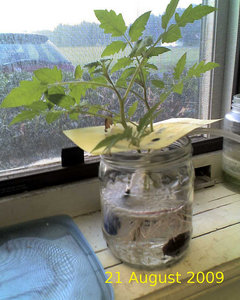
the second is a tomato plants grown only using an airstone in nutrient:
My point being that it appears either method of aeration works fine. why not combine them with an airlift that makes a waterfall? kind of like this: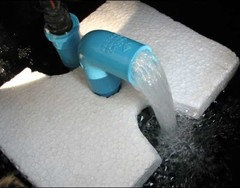
which was taken from this threadTheMasterGardener1
11 years agolast modified: 9 years agoCole Robbie,
You give a lot of advice I can see. It is based on experience? Can you show some pics of productive plants in your own hydroponic system?
Thanks ;)
cole_robbie
11 years agolast modified: 9 years agoMy stuff is seasonal, mostly based around the early tomato market in the spring. After about the middle of May, hydro is pointless for me, because I have good soil. It's easier to just plant in dirt than it is to keep a reservoir cool in 110 degree weather.
Here's my greenhouse:
{{gwi:298020}}Most of it is dedicated to plant starts:
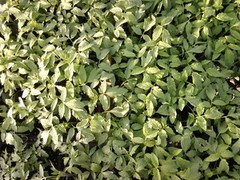
Flavor was my goal with my early tomatoes, so I didn't make them true hydro. They were in a soil-less mix and planted in a bucket with about 3" of water reservoir in the bottom. Looking through my pics, all I can find is the one I took of my first tomato:
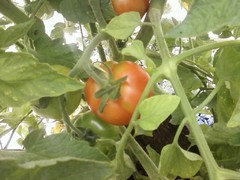
I also had cucumbers in the same setup. I was selling Sweet Success cukes at our first market day on 3/31, which is not bad for Illinois. They were also the only cucumbers I've ever enjoyed eating. Parthenocarpic = no seeds = best flavor.
Here are my tomatoes that I took to the farmer's market last week. These are from soil, but I think the pic is relevant because I was told I had never grown anything :)
{{gwi:1011573}}
By the way, I'm currently at a stage 4 of drought, the worst in 60 years, and a Federal disaster area, so I am happy to be producing anything.I agree that bubblers work well as cloners. You could cover that jar with aluminum foil and fit a dozen cuttings in it. The space advantage alone is tremendous.
RDWC systems are popular right now because they can grow giant plants and the design is so simple. The incoming water is supplied through the black tubing and each bucket is plumbed in a line or circle with the reservoir. Water pressure moves the water through the system as it is pulled out of the reservoir by the water pump. The hardest part is getting the plumbing to not leak. You have to carefully drill the hole and use the correct rubber grommet around the pvc. I would still not set up a system like that in a house where a water leak would be catastrophic unless the entire thing sat in a kiddie pool or pond liner as a back-up in case of a leak.
And if anyone is married to their air pump, you can put an airstone in each bucket just to make yourself happy. I'm not sure what the blue and green thing is in the bottom of that guy's bucket, but I wonder if to relates to his giant roots clogging the pvc.
I don't really like that design the best, but it shows how just minimal water flow is enough. Instead of buckets plumbed together, my design is more like a long trough of water, similar to the aeroflow, but much bigger. It does not need a large mass of water to work well...until it gets hot outside. Then it's the more, the better in regard to area of water around the roots. The mass of the water resists temperature fluctuations, and temperature for me is the biggest challenge of greenhouse hydro.
Now that I have the soil-less tomatoes producing fruit that I think is fit to eat, I am going to dedicate more space to them next spring. My crazy idea for next year is to have all of my buckets sit in a big styrofoam box in which I can control the climate. I think if I put a window air conditioner in the side of the box, I could make the plants keep producing quality fruit through the month of June. Soil tomatoes come in to my market at about July 4th, so selling through June would max out my potential early tomato season.
The nirvana of hydro for me would be producing a tomato that tastes as good as one from the soil. My greenhouse tomatoes in May were absolutely better-tasting than anything else commercially available to me, anywhere, period. That's the test they had to pass before I grow a lot more of them. Standard commercial practice for spring greenhouse tomatoes in my area is to pick them green and gas them with ethylene to make them at least pink. People buy them, because they are desperate for tomatoes at that time of year, but I find them to be disgusting mush. Mine are tremendously better. But they still don't taste as good as my summer garden tomatoes. I'm not sure that such a thing is possible, but I'm going to keep trying.
rebelhead
11 years agolast modified: 9 years agoi thought that it was common knowledge that aeration takes place at the surface and that an air pump is simply circulating the water by means of agitation. they are used in small hobby systems because they are cheap and convenient. i have had two hobby systems before with one using an air pump and the other using a water pump as a fountain. that was the only difference in the systems. no difference in results of the plants.
btw a commercial system has nothing to do with what is best for growing the plants. it about making MONEY. the least spent in production the better. its all about keeping down the costs. you had better if you want to make a profit.btw cole, i've been thinking about the same thing with the tomato crop. if you can get red tomatoes earlier in the spring than the others at the farmers market when the demand is so high, thats where the money is. i'm thinking next year i'll try and get that early crop in and not even bother growing them in the hottest months. i may try a fall crop but it looks like to me that the demand is greatly diminished because people are kinda tired of eating them by then.
rebelhead
11 years agolast modified: 9 years agoa 65 watt compact florescent bulb is available at most places. they require a mogul base. a 400 watt hps or metal halide can be purchased at any electrical supply house for 80-200$ depending on brand. they are sold as high bay or low bay. low bay has a larger reflector. they are heavy because the ballast is attached to the fixture. its the best bargain though. can get it for 100$ probably.
a 4' shop light is around 10$ and has 2 40 watt tubes.
i bought a 100 watt metal halide fixture at lowes on clearance for 15$. its an outdoor utility light. i removed the socket and bulb, mounted it horizontally. i made a reflector from an aluminum pie pan. cost less than 20$ total. its good for seedlings.cole_robbie
11 years agolast modified: 9 years agoThat's good stuff with the re-purposed halide lights. Sometimes used ones are sold cheaply on ebay, as well, but it's hard to beat $15.
I had my first few container tomatoes by the first week of May, and I could have sold truckloads. I am going to tinker with some hydro experiments, but the bulk of my plants will be Early Girls in the same soilless mix. The tomatoes are small, but they are bright red and taste very good.
I also had good luck selling small container gardens of leaf lettuce. They are easy to grow, and in the very early spring, customers are desperate for green stuff. But when it gets hot, the bugs get bad for me. I think I need a screened-in and shaded tent inside the high tunnel. Everything changes when the weather turns hot: bugs, disease, and root-zone temps all become an issue.
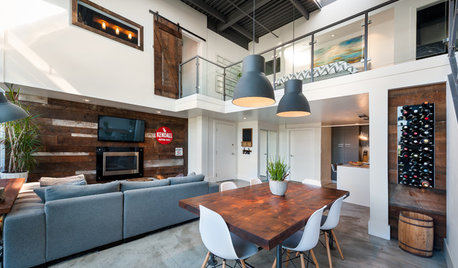
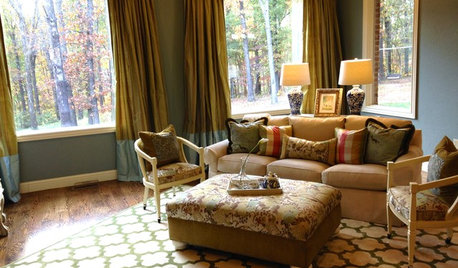
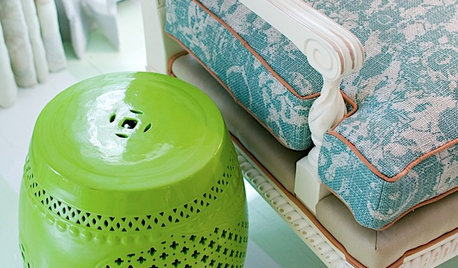

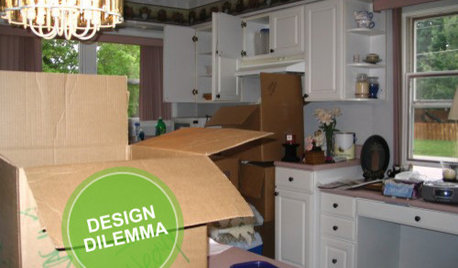











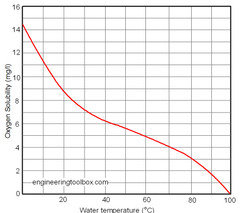
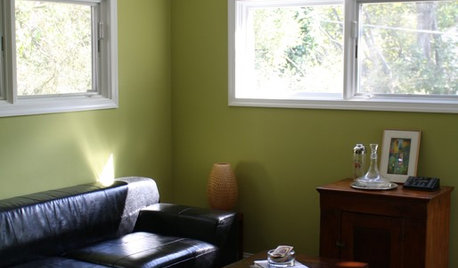
homehydro